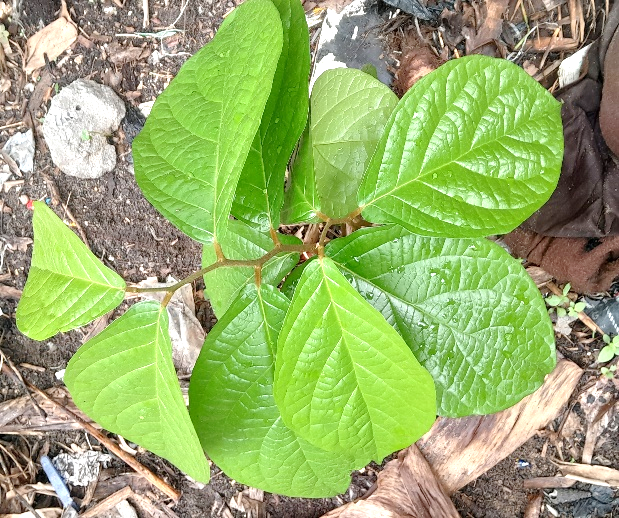Icacina tricantha

|
|
Icacina trichantha Common Names: Icacina, False Yam, Bush Banana Scientific
Classification Kingdom: Plantae Phylum: Streptophyta Class: Equisetopsida Subclass: Magnoliidae Order: Icacinales Family: Icacinaceae Genus: Icacina Species: I. trichantha Synonyms: Icacina senegalensis A.Juss., Icacina mannii Oliv. Morphological Description Icacina trichantha is a drought-resistant, perennial shrub or small tree,
typically 1–2 m tall, occasionally reaching 3 m. It produces large, yam-like
tubers (up to 5 kg) and bears distinctive fruits with intricate structures: · Fruit: Elliptical, 30.8–34.0 mm long, 17–24 mm wide, 12.0–18.7 mm
thick; matures to brown-black with a fuzzy epicarp covered in yellow, simple
hairs. Dried mesocarp ~300 μm thick, exposing a reticulate endocarp. · Endocarp: Elliptical (side view), spherical (cross-section), 27.4 mm
long, 17 mm wide, 14 mm thick; features 4 primary ridges (2 lateral extending
to base), forming 10–20 irregular polygonal spaces with free-ending ridgelets.
Wall thickness 270–315 μm (362–735 μm with ridges); composed of three layers:
outer (4–6 rows, 19–30 μm), middle (4–8 rows, 20–27 μm), inner (1 row, 8–13
μm). Contains eccentric pores near apex. · Leaves: Alternate, ovate to lanceolate, 5–15 cm long, hairy, with
serrated margins. · Flowers: Small, white to yellowish, borne in terminal clusters, hairy
(trichantha = "hairy flowers"). The tuber’s starchy
flesh and the fruit’s complex endocarp are key identifiers (Burkill, 1994). Distribution and Habitat Icacina trichantha is native to West and Central Africa, recorded in: · West Africa: Nigeria, Ghana, Senegal, Benin (annual rainfall 800–1,500
mm). · Central Africa: Cameroon, Democratic Republic of Congo. It thrives in woodlands,
savannas, and forest edges, often on sandy or lateritic soils (pH 5.0–6.5),
from sea level to 1,000 m altitude (Hutchinson et al., 1954). Ethnopharmacology Icacina trichantha, commonly known as false yam, is a tropical
plant native to West Africa, extensively utilized in traditional medicine for
treating ailments such as constipation, food poisoning, malaria, rheumatism,
toothache, hypertension, and asthma. Phytochemical analyses have identified
unique pimarane-type diterpenes within the plant, contributing to its diverse
pharmacological activities. Research indicates that I. trichantha exhibits
antioxidant, antimicrobial, anti-inflammatory, analgesic, antidiabetic, antimalarial,
and potential cytotoxic properties. These findings support its traditional
medicinal applications and highlight its potential for future therapeutic
developments. · Antimalarial: Tuber decoctions treat malaria in Nigeria. Ezenyi et
al. (2020) found ethanolic tuber extracts inhibited Plasmodium falciparum (IC₅₀ 15 μg/ml), linked to pimarane
diterpenes. · Hepatoprotective: Leaf extracts reverse liver damage in
Benin. Samuel et al. (2011) showed methanol leaf extracts (200 mg/kg) reduced
ALT/AST levels in arsenic-intoxicated rats by 40%, due to flavonoids. · Anti-inflammatory: Tuber poultices ease swelling in Ghana.
Asuzu et al. (1999) reported chloroform tuber fractions (100 mg/kg) reduced
carrageenan-induced paw edema in rats by 34%. · Emetic/Digestive: Tuber used for food poisoning in Nigeria.
Asuzu & Abubakar (1995) confirmed methanol tuber extracts (400 mg/kg)
induced emesis in guinea pigs, aiding detoxification. · Aphrodisiac: Root infusions enhance libido in Cameroon. Burkill (1994)
notes traditional use, though pharmacological evidence is pending. ⚠ Toxicity Profile: High doses of tuber extracts (>800 mg/kg in
mice) caused sedation and tremors, likely due to alkaloids. Leaf extracts
showed cytotoxicity in Allium cepa assays at 100% v/v, suggesting caution in
overuse (Olapade & Timothy, 2017). Additional Uses · Famine Food: Tubers, rich in starch, are boiled or processed into flour
during scarcity in Nigeria (Fay, 1987). · Ecological: Attracts pollinators like bees, supporting savanna
biodiversity (Burkill, 1994). References
External Links More Pictures |
|
| Compounds of Icacina tricantha | |
| References |